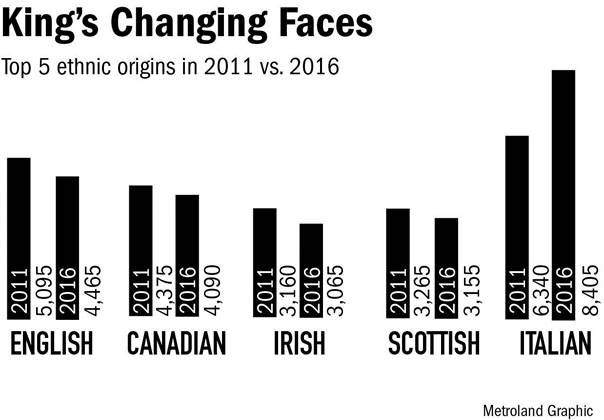
Changing faces: King Township grows to catch up on diversity
Despite being named the best place to live in York Region, data shows the rural community has not been a popular destination for immigrants
Yorkregion.com
Feb. 7, 2019
Sheila Wang
This is the first in a three-part series about newcomers in King Township, the challenges they face, and where they can turn for help.
Who doesn’t want to live in a mansion on a one-acre lot nestled in the beautiful rolling hills of the Oak Ridges Moraine? In King Township, that’s what you get, along with the picturesque concession roads and abundant farmland -- as long as you can afford it.
But despite being named the best place to live in York Region, data shows the rural community has not been a popular destination for immigrants.
King Township has slowly become more diverse but still lags behind the rest of York Region.
Less than 6,000 immigrants live in King, accounting for 25 per cent of the total population in 2016, up five per cent from five years earlier. That was significantly lower than the average of York Region, where immigrants made up 47 per cent of its population, according to 2016 census data.
“There was a great deal more diversity, from every country in Asia and Middle East. I was just very aware that the population has been more diverse than it was in 2010,” said Ward 5 Coun. Debbie Schaefer, who noticed a change out on the campaign trail last fall.
“It’s changing,” added Schaefer, who moved to King in 2003 after spending five years in Brussels, Belgium.
She recalled her shock to find the township overwhelmingly “white” -- in comparison with the hyper-diverse city of Brussels -- when campaigning for office for the first time in 2010.
Since then, King has put in more subdivisions, built new homes and renovated parks which have brought in a number of new residents of different backgrounds, Schaefer said.
But the fast-growing trend in minority population that's been widely observed elsewhere in the region hasn't taken place in King.
As a traditionally Italian community, King has seen its self-identified Italian population grow from 2011 to 2016, to 34 per cent from 32 per cent.
As a result, Italian descendants remained the largest ethnic group in the township.

“I think part of that may be spilled over from Vaughan. Vaughan has a very large population that claimed an Italian origin,” said Valerie Preston, a geography professor at York University.
Preston, who has done extensive research on migration and settlement in Canada, said there is no available research or analysis specifically on the diversity of King at the moment.
She said diversity is a difficult topic to talk about as King has not been a diverse place historically.
“It’s definitely not diverse. There is no diversity whatsoever,” said Riki Adivi, an Israeli immigrant who moved to King from Richmond Hill in 2015.
Adivi and her husband were among the only 85 self-identifying Israelis that lived in King Township, the 2016 census shows.
Having worked a few years in United States, Adivi and her husband drove a car from North Carolina with their two children, two dogs and one cat to Richmond Hill looking for a new home in Canada in 2006.
Nine years later, the family decided to move to King for a large converted church house just west of Highway 400.
“For a long time, I’d been looking for a place where I can have my dance classes,” said Adivi, a professional dance instructor who offers free dance classes at her house every Tuesday.
She immediately felt a difference living in King from Richmond Hill.
“There is no such location, except the grocery store, where you can go, you can meet people, you can say hi,” Adivi said.
As great place as it is to live in, King Township seems to be lacking opportunities for people to mingle and recognize the growing multiculturalism, she said.
In addition, the relatively high housing prices, fewer subdivisions and the geographically separated communities have contributed to the slow increase in diversity in King as well, Adivi added.
The average household income in King stood at around $191,000, and the average value of primary real estate was close to $1.5 million last year, according to MoneySense.
Schaefer agreed, noting the lack of options for alternative housing has also made the township less appealing to those who recently immigrated.
“We’re less urban, so many immigrants come from countries that are very big population centres. If they don’t know anybody and they’re trying to figure out where to live … if you’re used to the urban world, to go to place that doesn’t have public transit makes it even more of a challenge,” Schaefer said.
Schaefer has been working with King for Refugees, an independent not-for-profit organization that helps sponsor refugee families to find new lives in Canada.
The organization has helped four families from Syria and Ghana since 2012, and some of them have chosen to make King their new homes.
Schaefer said King for Refugees has been well connected with all services across York Region as they can access the Welcome Centre Immigration Services in Richmond Hill and educational services in Newmarket.
At the moment, the township doesn't have any service or policy in place to address the needs of the newcomers and immigrants, she said.
“King is very welcoming, and as our population changes, we do need to respond to that,” Schaefer said. "Immigration is very important to the country. I think in Canada we'll be far better off when immigrants are feeling fulfilled and really being able to integrate."
